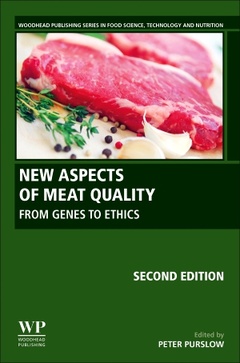Description
New Aspects of Meat Quality (2nd Ed.)
From Genes to Ethics
Woodhead Publishing Series in Food Science, Technology and Nutrition Series
Coordinator: Purslow Peter P.
Language: English
Subject for New Aspects of Meat Quality:
910 p. · 15.2x22.8 cm · Hardback
Description
/li>Contents
/li>Biography
/li>Comment
/li>
New Aspects of Meat Quality, Second Edition continues to be the leading source of scientific information for what constitutes meat quality for consumers, marketers and producers in the 21st century. The book includes traditional measures of meat quality such as texture, water holding, color, flavor/aroma, safety/microbiology and processing characteristics as well as quality assurance schemes, organic/free range, ethical meat production, and the desirability of genetically modified organisms, amongst others. Users will find comprehensive coverage on developments in our understanding of how muscle structure affects the eating qualities of cooked meat, along with techniques for measuring, predicting and producing meat quality.
In addition, the book covers how these new techniques help us minimize variability in eating quality and/or maximize value. The book's final section identifies the current qualities of consumer and public perceptions and what is sustainable, ethical, desirable and healthy in meat production and consumption.
1. Introduction
Part I: Developments in Our Understanding the Association Between Muscle Structure and the Basic Eating Qualities of Cooked Meat 2. Muscle Structure, Proteins, and Meat Quality 3. Myogenesis and Muscle Growth and Meat Quality 4. Perimortal Muscle Metabolism and its Effects on Meat Quality 5. What’s New in Meat Oxidation? 6. Current Developments in Fundamental and Applied Aspects of Meat Color 7. Advances in the Understanding and Measurement of Meat Texture 8. Developments in Our Understanding of Water-Holding Capacity in Meat 9. Current Challenges in Enhancing the Microbiological Safety of Raw Meat 10. Quality Assurance Schemes in Major Beef-Producing Countries
Part II: New Techniques for Measuring, Predicting and Producing Meat Quality, and How They Help us Minimize Variability in Eating Quality and/or Maximize Value 11. Transcriptomics of Meat Quality 12. Gene and Protein Expression as a Tool to Explain/Predict Meat (and Fish) Quality 13. NMR Spectroscopy and NMR Metabolomics in Relation to Meat Quality 14. X-ray Contrast Tomography and Raman Spectroscopy Methods Show Heat-Induced Changes in Meat 15. Cooking and Novel Postmortem Treatments to Improve Meat Texture 16. New Sources of Animal Proteins: Cultured Meat 17. New Sources of Animal Proteins: Edible Insects
Part III: The Current Qualities of Consumer and Public Perceptions; What is Sustainable, Ethical, Desirable and Healthy 18. Meat Nutritive Value and Human Health 19. Meat and Cancer Evidence for and Against 20. Manipulating the Fatty Acid Composition of Meat to Improve Nutritional Value and Meat Quality 21. Fundamentals of Animal Welfare in Meat Animals and Consumer Attitudes to Animal Welfare 22. How to Work With Large Meat Buyers to Improve Animal Welfare 23. Veterinary Drug Residues in Meat-Related Edible Tissues 24. Specific Veterinary Drug Residues of Concern in Meat Production 25. Ethics of Meat Production and Its Relation to Perceived Meat Quality 26. Ethical and Sustainable Aspects of Meat Production; Consumer Perceptions and System Credibility 27. Sensory Perceptions and New Consumer Attitudes to Meat
- Provides the latest research techniques and developments presented by top researchers in the field
- Covers new aspects of meat quality with the same scientific authority as texts on traditional meat quality value
- Includes five new chapters that cover the role of proteolysis, meat flavor, meat bi-products, and meat and public health




